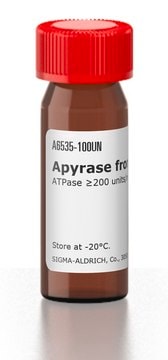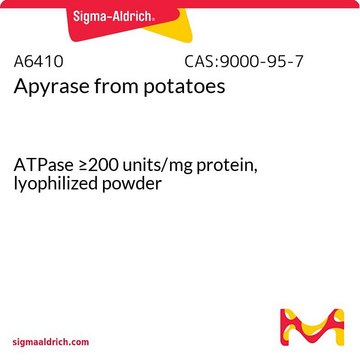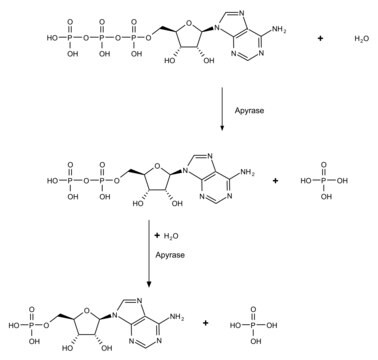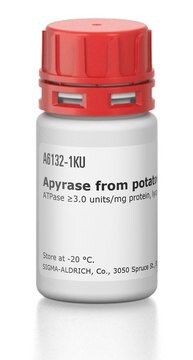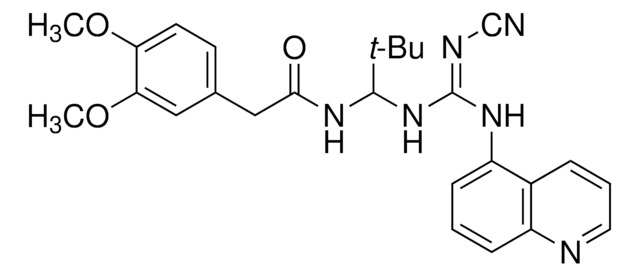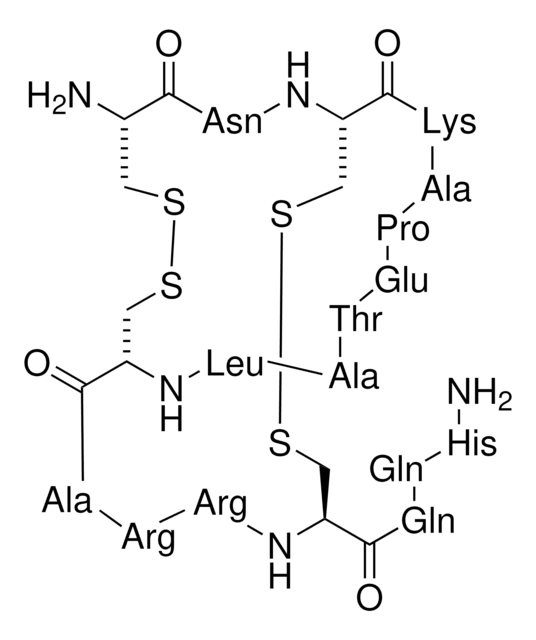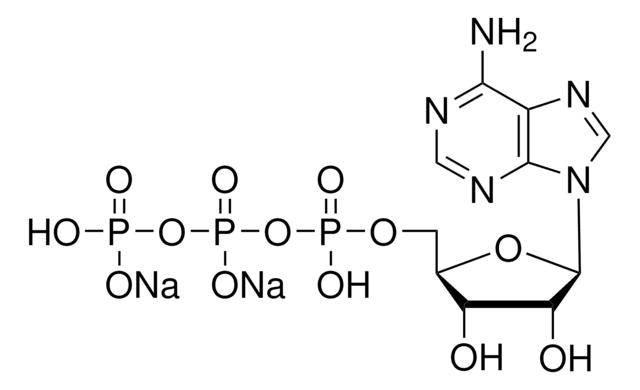A7646
Apyrase from potatoes
ATPase ≥60 units/mg protein, lyophilized powder (partially purified)
Synonym(s):
Adenosine 5′-diphosphatase, Adenosine 5′-triphosphatase
Sign Into View Organizational & Contract Pricing
All Photos(2)
About This Item
Recommended Products
biological source
potato
type
Grade III
form
lyophilized powder (partially purified)
ATPase activity
≥60 units/mg protein
mol wt
~49 kDa by gel filtration
composition
Protein, 30-60%
solubility
H2O: soluble 10 mg/mL, slightly hazy
application(s)
diagnostic assay manufacturing
foreign activity
Acid Phosphatase ≤5% of base activity
storage temp.
−20°C
Looking for similar products? Visit Product Comparison Guide
Related Categories
Application
Apyrase is used to hydrolyze nucleoside triphosphates and diphosphates. For hydrolysis of organic di and triphosphates, the optimal pH is 6, and for inorganic substrates, the optimal pH is 5.1 Apyrase, from Sigma, has been used in inhibition studies of platelet-aggregation. The enzyme has been used to assess the possibility of ATP involvement in intestinal lamina propria Th17 cell differentiation.
At least two isoenzymes are found in different varieties of S. tuberosum: one with a high ATPase/ADPase ratio (∼10) and another with a low ratio (∼1).
Reaction: ATP → ADP+Pi → AMP+2Pi.
Reaction: ATP → ADP+Pi → AMP+2Pi.
Biochem/physiol Actions
Apyrase is found in all eukaryotes and some prokaryotes. Apyrase, from potato, has a crucial role in regulating growth and development. Apyrase is involved in the inactivation of synaptic ATP as a neurotransmitter following nerve stimulation and in the inhibition of ADP induced platelet aggregation to prevent thrombosis. Divalent metal ions are required for activity and best activity is observed with calcium ion at 5 mM. The molecular weight of the protein is found to be approximately 45 kDa.
Packaging
Sold on the basis of ATPase units
Other Notes
Mixture of high and low ratio isoenzymes.
Quality
Contains ≤ 5% acid phosphatase.
Unit Definition
One unit will liberate 1.0 μmole of inorganic phosphate from ATP or ADP per min at pH 6.5 at 30 °C.
Signal Word
Danger
Hazard Statements
Precautionary Statements
Hazard Classifications
Resp. Sens. 1
Storage Class Code
11 - Combustible Solids
WGK
WGK 1
Flash Point(F)
Not applicable
Flash Point(C)
Not applicable
Personal Protective Equipment
dust mask type N95 (US), Eyeshields, Gloves
Choose from one of the most recent versions:
Already Own This Product?
Find documentation for the products that you have recently purchased in the Document Library.
Customers Also Viewed
Yen-Ta Chen et al.
Journal of tissue engineering and regenerative medicine, 13(12), 2155-2168 (2019-09-11)
This study tested the hypothesis that preactivated and disaggregated shape-changed platelet (PreD-SCP) therapy significantly protected rat kidney from ischemia-reperfusion (IR) injury. Adult-male Sprague-Dawley rats (n = 24) were equally categorized into Groups 1 (sham-operated control [SC]), 2 (SC + PreD-SCP)
Properties of Two Apyrases from Solanum tuberosum
Kettlun, A. et al.
Phytochemistry, 21(3), 551-558 (1982)
Koji Atarashi et al.
Nature, 455(7214), 808-812 (2008-08-22)
Interleukin (IL)-17-producing CD4(+) T lymphocytes (T(H)17 cells) constitute a subset of T-helper cells involved in host defence and several immune disorders. An intriguing feature of T(H)17 cells is their selective and constitutive presence in the intestinal lamina propria. Here we
Mathieu F Chevalier et al.
Blood, 121(1), 29-37 (2012-10-09)
Natural regulatory T cells (Tregs) participate in responses to various chronic infections including HIV. HIV infection is associated with a progressive CD4 lymphopenia and defective HIV-specific CD8 responses known to play a key role in the control of viral replication.
Nicholas J Roberts et al.
Plant physiology, 161(1), 556-567 (2012-11-09)
Nodulation in legumes requires the recognition of rhizobially made Nod factors. Genetic studies have revealed that the perception of Nod factors involves LysM domain receptor-like kinases, while biochemical approaches have identified LECTIN NUCLEOTIDE PHOSPHOHYDROLASE (LNP) as a Nod factor-binding protein.
Our team of scientists has experience in all areas of research including Life Science, Material Science, Chemical Synthesis, Chromatography, Analytical and many others.
Contact Technical Service